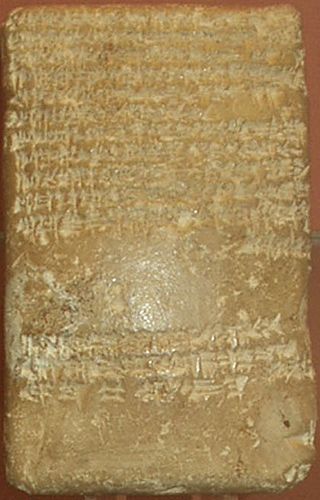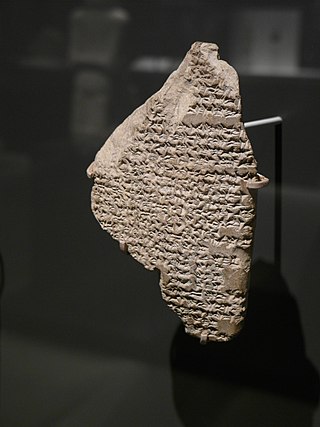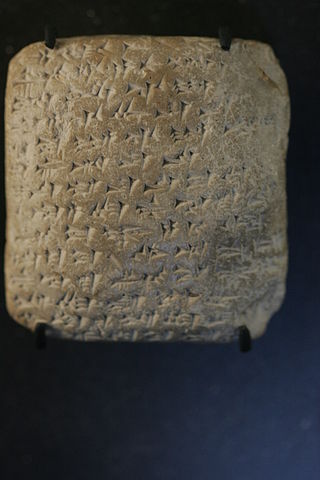
The Amarna letters are an archive, written on clay tablets, primarily consisting of diplomatic correspondence between the Egyptian administration and its representatives in Canaan and Amurru, or neighboring kingdom leaders, during the New Kingdom, spanning a period of no more than thirty years in the middle 14th century BC. The letters were found in Upper Egypt at el-Amarna, the modern name for the ancient Egyptian capital of Akhetaten, founded by pharaoh Akhenaten during the Eighteenth Dynasty of Egypt.
Pirissi and Tulubri are a pair of messengers of the 1350–1335 BC Amarna letters correspondence. Pirissi and Tulubri are the messengers of King Tushratta of Mitanni, and are referenced in Amarna letters EA 27, 28, and EA 29,.
Abimilki around 1347 BC held the rank of Prince of Tyre, during the period of the Amarna letters correspondence. He is the author of ten letters to the Egyptian pharaoh, EA 146–155. In letter EA 147, Pharaoh Akhenaten confirmed him as ruler of Tyre upon the death of his father, and in EA 149, referred to him with the rank of rabisu (general).

Amarna letter EA 19 is a tall clay tablet letter of 13 paragraphs, in relatively pristine condition, with some minor flaws on the clay, but a complete enough story that some included words can complete the story of the letter. Entitled "Love and Gold", the letter is about gold from Egypt, love between father-king ancestors and the current relationship between the King of Mitanni and the Pharaoh of Misri (Egypt), and marriage of women from King Tushratta of Mitanni to the Pharaoh of Egypt.

Amarna letter EA 161, titled An Absence Explained, is a tall clay tablet letter of 8 paragraphs, with single paragraphing lines. The surface is somewhat degraded, but most cuneiform signs that remain, allow for a relative complete translation context for the letter, and the eight paragraphs. The clay tablet is no. BM 29818 at the British Museum; the number is visible at the top of the tablet, above Para I-(in black ink, the top half of the number visible).

Amarna letter EA 9 is a tall, compact 38 line clay tablet letter of 3 paragraphs, in pristine condition, with few flaws on the clay. The photo of the reverse (pictured) shows half of Paragraph III, and some of the signs.

Amarna letter EA 252, titled: Sparing One's Enemies, is a square, mostly flat clay tablet letter written on both sides, and the bottom edge. Each text line was written with a horizontal line scribed below the text line, as well as a vertical left margin-line, scribe line on the obverse of the tablet. The letter contains 14 (15) lines on the obverse, continuing on the bottom tablet edge to conclude at line 31 on the reverse, leaving a small space before the final tablet edge. At least 4 lines from the obverse intrude into the text of the reverse, actually dividing the reverse into a top half and bottom half, and even creating a natural spacing segue to the reverse's text, and the story.

The cuneiform ŠEŠ sign, as a capital letter (majuscule), is a Sumerogram for Akkadian language ahu, for "brother". It is the cuneiform sign for ŠEŠ, as it can be used for a variety of lower case syllabic values, using š + vowel + š,. Sumerogram ŠEŠ has a high usage in the mid-14th century BC, ~1350-1330 BC Amarna letters from the brother kingdoms to the Pharaoh's Egypt. The brother kingdoms were Babylon, Alashiya, and Mittanni, where King Tushratta authored 13 El Amarna letters.

Amarna letter EA 325, titled: "Preparations Completed (2)," is a shorter-length clay tablet Amarna letter from Yidya the governor-'mayor' of Ašqaluna. It is a letter addressing the Pharaoh in high terms, as well as stating the 'governor of Ašqaluna' is making preparations for the arrival of the Pharaoh's archer-army, the archers. EA 325 is a vassal-state letter, and has some similar appearances, for example appearing like letters EA 270 and EA 271.

Amarna letter EA 15, titled Assyria Joins the International Scene, is a shorter-length clay tablet Amarna letter from Ashur-uballit I of the Land of Assyria,. He addresses the Pharaoh in line 1, the "King (of) Land Miṣri-(Egypt)", thus the use of "Land (of) Assyria".

Amarna Letter EA5, one of the Amarna letters, is a correspondence between Kadašman-Enlil I and Amenhotep III.

Amarna Letter EA10 is the letter of the Amarna series of diplomatic correspondence designated EA 10, which is written in cuneiform writing showing the continuation of a correspondence between Burna-Buriash II an ancient king of Babylon, and Akhenaten, an ancient pharaoh of Egypt.

Amarna letter EA 323, titled: A Royal Order for Glass, is a smaller, square, mostly flat clay tablet letter written on both sides, but only half of the reverse; it is also written on the bottom, and is a letter from 'governor' Yidya, and is a short letter like many of his other Amarna letters, numbered EA 320 to EA 326.

Amarna letter EA 23, titled: "A Goddess Travels to Egypt", is a short letter to Pharaoh from Tushratta. Due to the ill health of Pharaoh, a statue of Goddess Šauška is being sent to Egypt, to aid in the health of Pharaoh.

Amarna letter EA 38, titled A Brotherly Quarrel, is a letter from the King of Alashiya. One identifier of many of the Amarna letters, is the use of paragraphing. Six paragraphs are in this letter, with much of the letter's reverse – uninscribed.

Amarna letter EA 39, titled: "Duty-Free", is a fairly short letter from the King of Alashiya. Almost half the letter, Para I, is a shortened greeting formula. The letter is requesting the Pharaoh to let messengers pass freely, as they are also being represented as merchants; this also applies to their shipping.

Amarna letter EA 156, titled: "Aziru of Amurru", is a very short letter from Aziru, the leader of the region of Amurru. EA 156 is the first letter in a series of 16 letters regarding Aziru.

Amarna letter EA 158, titled: "Father and Son", is a moderate length letter from Aziru, the leader of the region of Amurru. The letter is written to the Egyptian official, Tutu/ (Dudu). EA 158 is the third letter in a series of 16 letters regarding Aziru.

Amarna letter EA 34, titled: "The Pharaoh's Reproach Answered", is a moderately tall clay tablet Amarna letter from the King of Alashiya.
Amarna letter EA 147, titled A Hymn to the Pharaoh, is a moderate length clay tablet Amarna letter from Abimilku of Tyre-(called Ṣurru in the Abimilku letters, and an island, until the time of Alexander the Great, 330 BC). The letter is a twin letter to EA 149, which is identical in length, and complexity, and EA 147 appears to precede EA 149.














